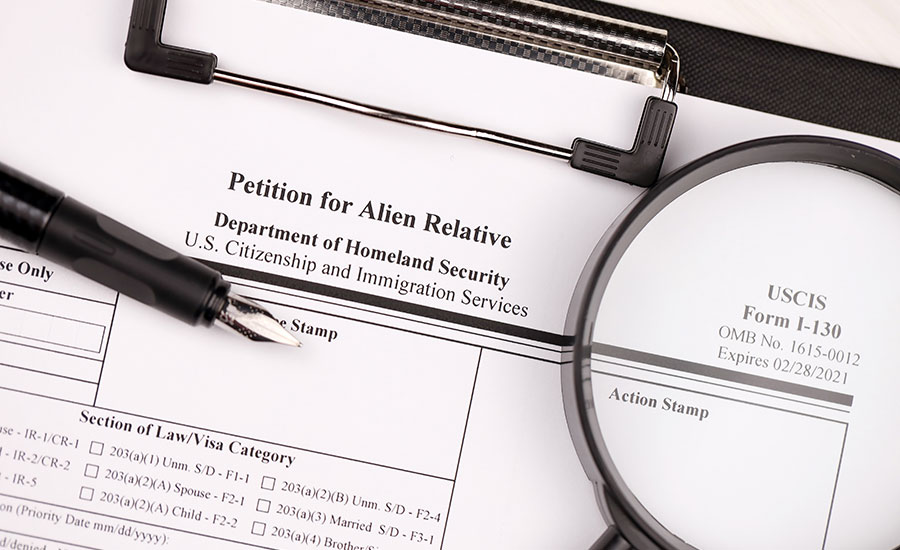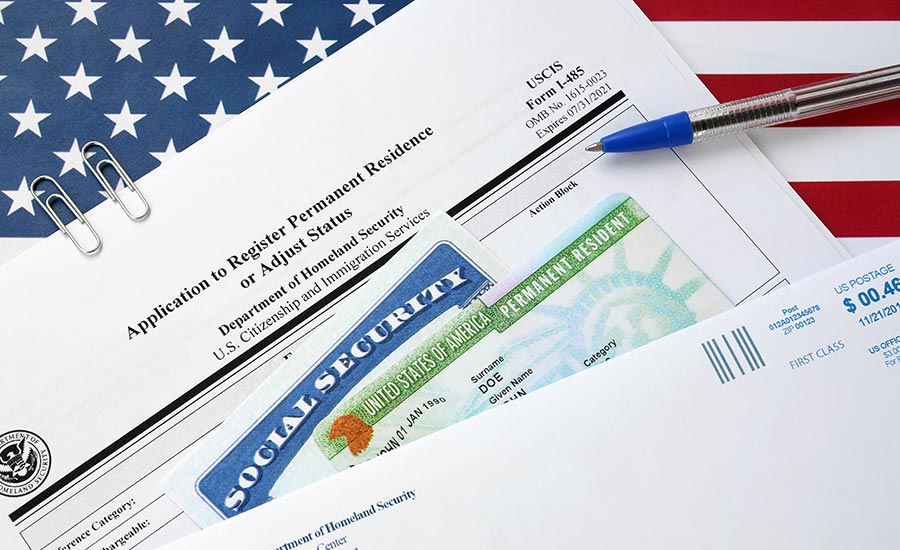

Did you know that Form I-130 is the first step in the immigration journey if you want to bring a family member to the United States?
We have created a detailed guide to Form I-130, covering eligibility, the filing process, and answers to common questions. Read on to understand how to bring your loved ones closer.
What Is Form I-130?
Form I-130, Petition for Alien Relative, is a document filed by a U.S. citizen or lawful permanent resident (Petitioner) to show a valid family relationship with a relative (Beneficiary) who wishes to immigrate to the United States.
Who Can File I-130?
While both U.S. citizens and Green Card holders can file Form I-130 with the U.S. Citizenship and Immigration Services (USCIS), the eligible family members they can sponsor, and the related conditions differ significantly.
A U.S. citizen can file Form I-130 for:
- Immediate relatives, such as a spouse, unmarried children under 21 years old, and parents. In these types of cases, there are no visa caps or waiting periods.
- Other family members, such as unmarried sons or daughters aged 21 or older, married sons or daughters of any age, and siblings. These types of cases are subject to visa caps and waiting time.
A Green Card holder can file I-130 for:
- A spouse — subject to visa availability under the family preference category, which may result in waiting periods.
- Unmarried children — subject to annual visa caps, depending on the child’s age and country of origin.

Who Cannot Be Sponsored With Form I-130?
There are relatives for whom Form I-130 cannot be filed — these include:
- Grandparents
- Grandchildren
- Cousins
- Aunts or uncles
- In-laws
- Adopted children who were not adopted before turning 16
- Stepchildren or stepparents if the relationship did not begin before the stepchild turned 18
Form I-130: The Process
Filing Form I-130 is a process that requires careful preparation and attention to detail — check out the step-by-step guide we prepared.
1. Find Form I-130
Visit the USCIS website and find I-130 in the All Forms section.
Download the latest version of Form I-130 for paper filing or create an online account to file electronically.
2. Review Instructions
Carefully read Form I-130 instructions to understand the eligibility criteria, filing requirements, and necessary supporting documents.
3. Gather Supporting Documents
Collect evidence to prove your U.S. citizenship or permanent residency and establish the family relationship with the beneficiary.
These may include:
- Birth certificates
- Marriage certificates
- Certificates of name changes
- Proof of nationality
- Divorce decrees (if applicable)
- Passport or Green Card copy
4. Complete The Form
Fill out Form I-130, providing details about both you as a petitioner and the relative as a beneficiary.
If you are filing for your spouse and they are in the U.S., they must complete Form I-130A, Supplemental Information for Spouse Beneficiary as part of the package.
If your spouse is outside the U.S., you as a petitioner can fill out and submit Form I-130A on their behalf.
5. Pay The Filing Fee
Submit the filing fee via credit card, check, or money order (if filing by mail) or online through your USCIS account.
6. File The Form
You can file Form I-130 by mail or electronically.
If you are filing by mail, submit Form I-130 along with the fee payment and supporting documents to the appropriate USCIS Lockbox address as follows:
- If you are only filing Form I-130 and live in Alaska, American Samoa, Arizona, California, Colorado, Commonwealth of the Northern Mariana Islands, Florida, Guam, Hawaii, Idaho, Kansas, Montana, Nebraska, Nevada, New Mexico, North Dakota, Oklahoma, Oregon, Puerto Rico, South Dakota, Texas, Utah, U.S. Virgin Islands, Washington, or Wyoming, send the form to:
USCIS Phoenix Lockbox
U.S. Postal Service (USPS) deliveries:
USCIS
Attn: I-130
P.O. Box 21700
Phoenix, AZ 85036-1700
FedEx, UPS, and DHL deliveries:
USCIS
Attn: I-130 (Box 21700)
2108 E. Elliot Rd.
Tempe, AZ 85284-1806
- If you are only filing Form I-130 and live in Alabama, Arkansas, Armed Forces Americas, Armed Forces Europe, Armed Forces Pacific, Connecticut, Delaware, Georgia, Illinois, Indiana, Iowa, Kentucky, Louisiana, Maine, Marshall Islands, Maryland, Massachusetts, Michigan, Micronesia, Minnesota, Mississippi, Missouri, New Hampshire, New Jersey, New York, North Carolina, Ohio, Palau, Pennsylvania, Rhode Island, South Carolina, Tennessee, Vermont, Virginia, Washington, D.C., West Virginia, or Wisconsin, send the form with supporting documents to:
USCIS Elgin Lockbox
U.S. Postal Service (USPS):
USCIS
Attn: I-130
P.O. Box 4053
Carol Stream, IL 60197-4053
FedEx, UPS, and DHL deliveries:
USCIS
Attn: I-130 (Box 4053)
2500 Westfield Drive
Elgin, IL 60124-7836
- You are only filing Form I-130 and live outside the U.S., send it to:
USCIS Elgin Lockbox
U.S. Postal Service (USPS):
USCIS
Attn: I-130
P.O. Box 4053
Carol Stream, IL 60197-4053
FedEx, UPS, and DHL deliveries:
USCIS
Attn: I-130 (Box 4053)
2500 Westfield Drive
Elgin, IL 60124-7836
- If you are filing Form I-130 together with Form I-485, Application to Register Permanent Residence or Adjust Status, send the package of documents to the respective USCIS address.
If you are filing Form I-130 electronically, submit it through the USCIS online system.
If you are requesting a fee waiver, you must file Form I-130 by mail and cannot submit it online.
7. Wait For Receipt Notice
Once USCIS receives your application, they will send you Form I-797C, Notice of Action, as proof of submission. The notice will contain a receipt number which you can use to track your case.
8. Respond To Requests For Evidence
If USCIS requires additional documentation, they will send out a Request for Evidence (RFE). Be sure to respond promptly to avoid delays.
9. Wait For A Decision
- If Form I-130 is approved and the beneficiary is outside the U.S., their case will be transferred to the National Visa Center (NVC) for consular processing (check out NVC processing time).
- If Form I-130 is approved and the beneficiary is inside the U.S., they can proceed with filing Form I-485 (provided they meet the eligibility criteria).
- If Form I-130 is denied, you may have the option to file an appeal or motion to reopen or reconsider the case. Reach out to the experienced attorneys at Spar & Bernstein for legal advice.

Form I-130: Cost
- If you are filing Form I-130 on paper, the fee is $675.
- If you opt for online submission, the fee for I-130 is $625.
- If you are filing for an Afghan beneficiary with an immediately available immigrant visa, there is currently no fee (through Sept. 30, 2025).
Form I-130: Processing Time
Processing time for Form I-130 varies depending on whether you are a U.S. citizen or lawful permanent resident (LPR), your relationship with the beneficiary, and USCIS workload at their field offices and service centers.
Here are Form I-130 processing times if you are a U.S. citizen:
- 16 to 62 months — if you are filing for a spouse, child under 21 years old, or a parent
- 53 to 113 months — for an unmarried child who is 21 years old or older
- 55 to 94 months — for a married son or daughter
- 94 months — for a brother or sister
If you are a Green Card holder, the average processing times for Form I-130 are:
- 54 to 84 months — if you are filing for a spouse or child under 21
- 52 to 113 months — for an unmarried child who is 21+ years old
Need Help With Form I-130? Schedule A Consultation
Need help filing Form I-130?
Dedicated to guiding families through the labyrinth of immigration forms and processes, the knowledgeable and compassionate team of attorneys at Spar & Bernstein will:
- Clearly explain eligibility requirements in straightforward, accessible language.
- Assist in completing and filing Form I-130 accurately.
- Provide guidance on responding to a Request for Evidence (RFE) from USCIS.
- Advise on next steps after Form I-130 approval, whether it involves adjustment of status in the U.S. or consular processing abroad.
- Appeal or file a motion to reopen if your petition or application is denied.
Representing you every step of the way, our team of immigration lawyers at Spar & Bernstein work tirelessly to help you reunite with your loved ones.
Form I-130: FAQs
For more insights into Form I-130, check out our frequently asked questions section.
Can I file Form I-130 for several family members at the same time?
Yes, you can petition for several family members at the same time. However, you must file a separate Form I-130 for each of them. For example, if you want to sponsor both your spouse and child, you need to file two separate forms and pay the filing fee for each one individually.
Does filing Form I-130 give a visa immediately?
No, Form I-130 does not provide a visa immediately — it is only the first step in the immigration process. Once the form is approved, the beneficiary must undergo additional steps, such as consular processing or adjustment of status. They may also need to wait for a visa to become available in their category.
Can I file Form I-130 to bring my fiancé(e) to the U.S.?
No, Form I-130 is used for established family relationships. To bring your fiancé, file Form I-129F for a K-1 (fiancé) visa.
Can I use Form I-130 to sponsor my stepchild?
Yes, you can file Form I-130 for a stepchild, provided the stepchild relationship was established before the child turned 18. If they are over this age, talk to our experienced team of attorneys at Spar & Bernstein to understand your options.
Do I need a lawyer to file Form I-130?
No, you can file Form I-130 on your own. However, having a trusted attorney, like our team at Spar & Bernstein, by your side may be valuable if your case is complex or requires additional documentation.
Does the I-130 beneficiary need to sign the form?
No, the only person who must sign Form I-130 is the U.S. citizen or lawful permanent resident. The beneficiary is not required to sign the form.
Do I need to submit Form I-864 at the same time as Form I-130?
No, Form I-864, Affidavit of Support, is not filed with Form I-130. It is submitted later in the process, either during consular processing after Form I-130 is approved or alongside Form I-485 when applying for adjustment of status in the U.S.





